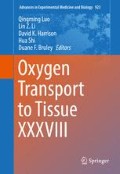Abstract
Given the clinical evidence that hypoxic tumors are more resistant to standard therapy and that adjusting therapies can improve the outcomes for the subpopulation with hypoxic tumors, in vivo methods to measure oxygen in tissue have important clinical potential. This paper provides the rationale for and methodological strategies to use comparative effectiveness research to evaluate oximetry for cancer care. Nine oximetry methods that have been used in vivo to measure oxygen in human tumors are evaluated on several clinically relevant criteria to illustrate the value of applying comparative effectiveness to oximetry.
Access this chapter
Tax calculation will be finalised at checkout
Purchases are for personal use only
References
Vaupel P, Höckel M, Mayer A (2007) Detection and characterization of tumor hypoxia using pO2 histography. Antioxid Redox Signal 9:1221–1236. doi:10.1089/ars.2007.1628
Walsh JC, Lebedev A, Aten E et al (2014) The clinical importance of assessing tumor hypoxia: relationship of tumor hypoxia to prognosis and therapeutic opportunities. Antioxid Redox Signal 21:1516–1554. doi:10.1089/ars.2013.5378
Vaupel P, Mayer A (2007) Hypoxia in cancer: significance and impact on clinical outcome. Cancer Metastasis Rev 26:225–239. doi:10.1007/s10555-007-9055-1
Wilson WR, Hay MP (2011) Targeting hypoxia in cancer therapy. Nat Rev Cancer 11:393–410. doi:10.1038/nrc3064
Menon C, Fraker DL (2005) Tumor oxygenation status as a prognostic marker. Cancer Lett 221:225–235. doi:10.1016/j.canlet.2004.06.029
Bussink J, Kaanders JH, von der Kogel AJ (2002) Tumor hypoxia at the micro-regional level: clinical relevance and predictive value of exogenous and endogenous hypoxic cell markers. Radiother Oncol 67:3–15. doi:10.1016/S0167-8140(03)00011-2
Janssens GO, Rademakers SE, Terhaard CH et al (2012) Accelerated radiotherapy with carbogen and nicotinamide for laryngeal cancer: results of a phase III randomized trial. J Clin Oncol 30:1777–1783. doi:10.1200/JCO.2011.35.9315
Gatsonis C (2010) The promise and realities of comparative effectiveness research. Stat Med 29:1977–1981. doi:10.1002/sim.3936
Goss CH, Tefft N (2013) Comparative effectiveness research—what is it and how does one do it? Paediatr Respir Rev 14:152–156. doi:10.1016/j.prrv.2013.06.006
Amstrong K (2012) Methods in comparative effectiveness research. J Clin Oncol 30:4208–4214. doi:10.1200/JCO.2012.42.2659
Holve E, Pittman P (2009) A first look at the volume and cost of comparative effectiveness research in the United States. Academy health. http://www.academyhealth.org/files/filedownloads/ah_monograph_09final7.pdf. Accessed 30 Aug 2015
Tunis SR, Stryer DB, Clancy CM (2003) Practical clinical trials: increasing the value of clinical research for decision making in clinical and health policy. JAMA 290:1624–1632. doi:10.1001/jama.290.12.1624
Epstein R, Teagarden JR (2010) Comparative effectiveness and personalized medicine: evolving together or apart? Health Aff (Millwood) 29:1783–1787. doi:10.1377/hlthaff.2010.0642
O’Connor AM, Llewellyn-Thomas HA, Flood AB (2004) Modifying unwarranted variations in health care: shared decision making using patient decision aids. Health Aff (Millwood) Suppl Variation: VAR63–72. doi:10.1377/hlthaff.var.63
Clinicaltrials.gov (2015) U.S. National Institutes of Health, Rockville. http://www. clinicaltrials.gov. Accessed 25 Aug 2015
Dhani N, Fyles A, Hedley D et al (2015) The clinical significance of hypoxia in human cancers. Semin Nucl Med 45:110–121. doi:10.1053/j.semnuclmed.2014.11.002
Koch CJ, Evans SM (2015) Optimizing hypoxia detection and treatment strategies. Semin Nucl Med 45:163–176. doi:10.1053/j.semnuclmed.2014.10.004
Overgaard J (2011) Hypoxic modification of radiotherapy in squamous cell carcinoma of the head and neck—a systematic review and meta-analysis. Radiother Oncol 100:22–32. doi:10.1016/j.radonc.2011.03.004
Springett R, Swartz HM (2007) Measurements of oxygen in vivo: overview and perspectives on methods to measure oxygen within cells and tissues. Antioxid Redox Signal 9:1295–1301. doi:10.1089/ars.2007.1620
Swartz HM, Williams BB, Hou H et al. (2015) Direct and repeated clinical measurements of p02 for enhancing cancer therapy and other applications [submitted same issue]. In: Advances in experimental medicine and biology: oxygen transport to tissues XXXVIII. 43rd annual meeting of the International Society on Oxygen Transport to Tissue, Wuhan, China, 11–16 July 2015 (in press)
Nordsmark M, Eriksen JG, Gebski V et al (2007) Differential risk assessments from five hypoxia specific assays: the basis for biologically adapted individualized radiotherapy in advanced head and neck cancer patients. Radiother Oncol 83:389–397. doi:10.1016/j.radonc.2007.04.021
Vaupel P (2004) Tumor microenvironmental physiology and its implications for radiation oncology. Semin Radiat Oncol 14(3):198–206, doi:http://dx.doi.org/10.1016/j.semradonc. 2004.04.008
Acknowledgments
This work was funded in part by a grant from the US National Cancer Institute, National Institutes of Health (PO1CA190193).
Author information
Authors and Affiliations
Corresponding author
Editor information
Editors and Affiliations
Rights and permissions
Copyright information
© 2016 Springer International Publishing Switzerland
About this paper
Cite this paper
Flood, A.B., Satinsky, V.A., Swartz, H.M. (2016). Comparing the Effectiveness of Methods to Measure Oxygen in Tissues for Prognosis and Treatment of Cancer. In: Luo, Q., Li, L., Harrison, D., Shi, H., Bruley, D. (eds) Oxygen Transport to Tissue XXXVIII. Advances in Experimental Medicine and Biology, vol 923. Springer, Cham. https://doi.org/10.1007/978-3-319-38810-6_15
Download citation
DOI: https://doi.org/10.1007/978-3-319-38810-6_15
Published:
Publisher Name: Springer, Cham
Print ISBN: 978-3-319-38808-3
Online ISBN: 978-3-319-38810-6
eBook Packages: Biomedical and Life SciencesBiomedical and Life Sciences (R0)

